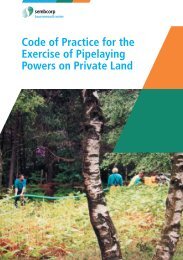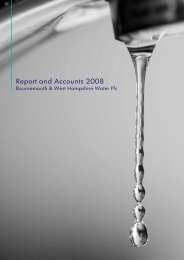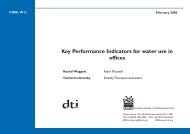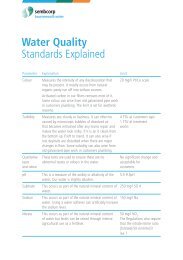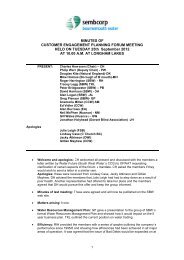New Forest - Sembcorp Bournemouth Water
New Forest - Sembcorp Bournemouth Water
New Forest - Sembcorp Bournemouth Water
- No tags were found...
You also want an ePaper? Increase the reach of your titles
YUMPU automatically turns print PDFs into web optimized ePapers that Google loves.
type of mire-heath ecosystem occurs both westwards into Dorsetand eastwards into Surrey and Sussex. However, the numbers ofintact valley mires declines away from the core area of the <strong>New</strong><strong>Forest</strong>, as does the diversity of plant communities.Phytosociologically the valley mires of the <strong>New</strong> <strong>Forest</strong> occupy adistinct position between the strongly Atlantic locations to thewest and the more Continental locations to the east. Locally,base-rich springs and small valley mires feature the communityCarex dioica – Pinguicula vulgaris. This community is principallyassociated with the uplands and its location within the <strong>New</strong><strong>Forest</strong> is regarded as unusual and important. The occurrence ofPinguicula lusitanica, found in this mire type and within somevalley mires is also considered important as it represents thewestern extreme of the southern core of distribution of thisspecies.A further important wetland habitat found within the <strong>New</strong><strong>Forest</strong> is pools located within the heath-mire matrix. Thesecontain nutrient enriched water and are characterised by a veryspecies rich assemblage of aquatic and associated plants. Someof these, such as Ludwigia palustris and Galium debile, arenationally rare.The valley mires and other peatland and wetland habitats withinthe <strong>New</strong> <strong>Forest</strong> are of major importance for invertebrates. Thereare differences in faunal composition between the various valleymires, so that it is the presence of the whole suite of mires thataccounts for the overall species richness, and the exceptionalvalue of the <strong>New</strong> <strong>Forest</strong> compared with other sites where farfewer valley mires are available. Sampling has demonstrated that10% of the fauna of individual mires is comprised of Red DataBook or national scarce species.Criterion 2aThe <strong>New</strong> <strong>Forest</strong> qualifies also under Criterion 2a by supportinga number of rare species of plants and animals. Seven speciesof nationally rare wetland plants are present. These are dwarfspikerush Eleocharis parvula; slender cottongrass Eriophorumgracile; slender bedstraw Galium debile; Hampshire purslaneLudwigia palustris; penny royal Mentha pulegium; and smallfleabane Pulicaria vulgaris. In addition, the following species ofnationally scarce wetland plants have been recorded: bog hairgrass Deschampsia setacea; bog orchid Hammarbya paludosa;pillwort Pillularia globifera; six-stammenned waterwort Elatinehexandra; slender spike-rush Eleocharis acicularis; marshgentian Gentiana pneumonanthe; coral necklace Illecebrumverticillatum; touch-me-not Impatiens noli-tangere; marshclubmoss Lycopodium inundatum; mousetail Myosurus minimus;corky-fruited water-dropwort Oenanthe pimpinelloides; yellowbartsia Parentucellia viscosa; annual beard grass Polypogonmonspeliensis; the annual herb Polygonum minus; three-lobedwater crowfoot Ranunculus tripartitus; brown beak sedgeRhynchospora fusca; marsh fern Thelypteris thelypteroides; andintermediate bladderwort Utricularia intermedia.The invertebrate fauna of the valley mires and associatedwetlands is particularly rich, reflecting the diversity and extentof the wetland habitats. At least 65 Red Data Book specieshave been recorded. These include species listed as endangered:the water weevils Bagous brevis, Bagous czwalinai, Bagouslongitarsis, and Bagous nodulosus, the dung beetle Aphodiusniger, the ground beetle Pterostichus aterrimus, the waterbeetles Bidessus unistriatus and Paracymus aeneus, the antFormic transcaucasica, the tadpole shrimp Triops cancriformis,the flea beetle Longitarsus ferrugineus, the ground beetlesTachys edmondsi and Tachys walkerianus and the horseflyChrysops sepulchralis; species listed as vulnerable: thesnail Lymnaea glabra, the marsh grasshopper Stethophymagrossum, the beetle Biblioplectus tenebrosus, the water beetlesAgabus brunneus, Graptodytes flavipes, Helophorus laticollis,Hydroporus rufifrons, the rove beetle Manda mandibularis,the micromoth Stenoptilia graphodactyla, the fly Phaoniajaroschewskii, the hoverfly Eristalis cryptorium, the aquaticcrustacean Chirocephalus diaphanus, the spider Thanatusformicinus, the money spider Trichonsuc hackman, the flyEyndyas nigripes, and the reed beetle Donacia bicolora; specieslisted as rare: the medicinal leech Hirudo medicinalis, the seaanemone Nematostella vectensis, the blue damselfly Coenagrionmercuriale, the ground bug Pachybrachius luridus, the waterbeetles Enochrus isotae, Haliplus variegatus, Helophoruslongitarsis, Hydrochus elongatus and Hydrovatus clypealis,the rove beetles Hygropora cunctans, Paederus caligatus, andAleochara discipennis, the leaf beetle Hydrothassa hannoveriana,the marsh moth Athetis pallustris, the moth Pelosia muscerda,the cranefly Tipula marginata, the horsefly Atylotus latiatriatus,the fly Dolichopus andalusiacus, the hoverfly Pelecocera tricincta,the fly Themira nigricornis, the snail killing fly Tetanocera frevi,the shrimp Gammarus insensibilis, the wolf spider Arctosafulvolineata, the ground beetle Anisodactylus poeciloides, theweevil Bagous frit, the water weevil Bagous colligensis, thesoldier beetle Cantheria fusca, the moths Crambus uliginosellusand Buckleria paludum, and the fly Telmaturgus tumidulus; andthe following species for which there is insufficient informationto place them in any category: the polychaete worm Armandiacirrhosa, the aquatic crustacean Allomelita pellucida, the groundhopper Limotettix atricapillus, and the horseflies Tabanusbovinus and Tabanus miki.Some of the species listed, like the tadpole shrimp, are onlyknown from the <strong>New</strong> <strong>Forest</strong> in Britain. The site also supportsthe major part of the British population of species such as thebog ant, the marsh grasshopper, and the aquatic crustaceanChirocephalus diaphanus.Criterion 2bThe <strong>New</strong> <strong>Forest</strong> qualifies under Criterion 2b because of the highecological quality and diversity of the mire communities andtheir undisturbed transition zones. The invertebrate fauna holdsimportant concentrations of rare and scarce wetland species. Thiscomplex of semi-natural habitats is essential to the maintenanceof the genetic and ecological diversity of southern England.Citation DetailsThe <strong>New</strong> <strong>Forest</strong> Special Protection Area for Wild birds (SPA)The site qualifies under Article 4.1 of the EC Directive 79/409 byregularly supporting the following species:Breeding: NightjarWoodlarkDartford warblerHoney buzzardKingfisher18 <strong>New</strong> <strong>Forest</strong> – Guidelines for maintenance operations within sensitive areas



